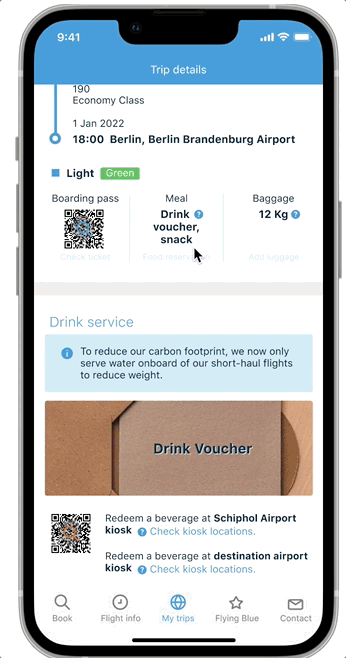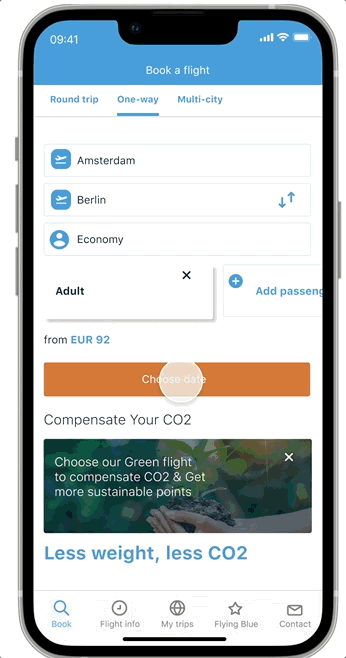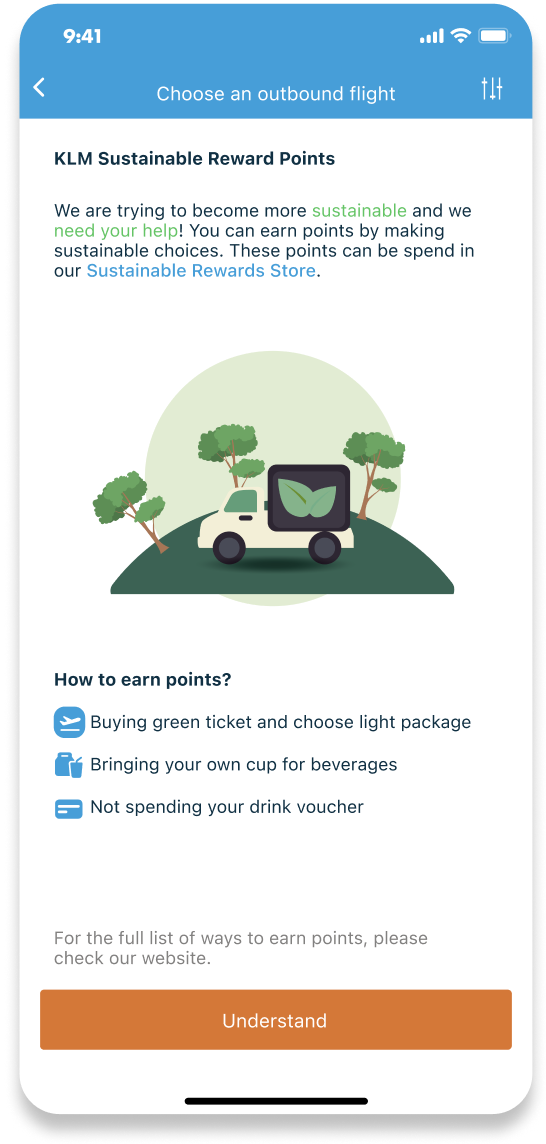
KLM-Airline APP
The concept focuses on passengers and is mainly directed towards economy class passengers and should be implementable by 2024. By changing the behavior of the passengers in a seamless way to make sustainable decisions.
User research, UX&UI Design, App Design
Period
January 2021 – August 2021
Contribution
User research, Concept development, Prototyping, UX/UI design, User testing
Highlights
New drink service
Reward store
New booking system
The challenge and scope
The challenge as given by KLM Cityhopper is the following:
Design a solution that enables KLM Cityhopper (KLC) to offer sustainable meals to users during their trip and helps identify key focus areas for KLC to work on, that make the catering ecosystem more sustainable.” Users in this sentence can mean either passengers or crew. Our concept focuses on passengers and is mainly directed towards economy class passengers, and it should be implemented by 2024.
Research
We conducted field research at the KLM airport to observe the environment and different kinds of food during the flight. In the meantime, we interviewed the KLM staff to have a better understanding of the challenge
Key findings
Despite KLM's reputation as the most sustainable airline, many people were unaware of its sustainability efforts and the importance of weight saving. This lack of awareness led to low passenger acceptance of these efforts.
KLM Cityhopper aims to be the most sustainable airline and values passenger contributions toward this goal. Effectively communicating their sustainability efforts and the reasons behind them could increase passenger willingness to contribute and accept any compromises made for sustainability.
Within the catering ecosystem itself, there are already a lot of stakeholders involved. Setting up a new process or concept often adds new stakeholders. The concept is designed for KLM Cityhopper and implementation, multiple departments within KLM would need to be involved. Interestingly enough, the stakeholder map involves mostly stakeholders from within KLM.
Vision
”To increase passenger contribution in KLCs objective to become more sustainable by making passengers aware to make more considered choices on board.”
In this vision, we focus on passengers, weight reduction, and drinks particularly. When it comes to weight, drinks have a more significant impact compared to food and apart from that, more drinks are loaded compared to food because the drinks are used in the weight (distribution) calculations.
As mentioned before, the Hook model has been one of the main handles in this phase of the project. The model is broken up into phases and for each phase, ideas were brainstormed.
Brainstorming was initiated with “how might we” questions. For each question, a timer was set, and individually all of us came up with ideas.
Sustainably positive behavior would be rewarded with so-called sustainable points which could be spent in the Sustainable Reward Store. An app interface was created as well as food packaging. During the booking process, the new drink service is introduced and explained to the passenger. The food service is used to create awareness for sustainability onboard by designing a new food packaging
Using the average flight time of 1h16 and the number of flights of KLM Cityhopper an estimation of yearly benefits was made. On a yearly basis, the reduction in weight of only serving water on board would save approximately 215000kg of fuel which translates to 552 tons of CO2. Further benefits could come from sustainable behavior changes in passengers once awareness is created about the importance of weight saving in aviation.
Conclusion
Information architecture
Solution space
Iteration
Brainstorm
Brainstorms often led to ideas and these ideas needed to become more graspable. For that reason, visualization sessions were done. In such a session we would set a timer and each team member would visualize their idea to later share with the team.
Decision making
The weight of the drinks on board is a fixed number to calculate with for weight distribution, meaning that on a flight with 10 passengers the same number of drinks (full trolleys) are loaded as on a fully booked flight. This leaves a lot of potential for improvement and this is why this became our area of focus. The choice was made to not focus on food waste, another area with potential and important problems to solve, given the short amount of time left in the project.
It starts with creating awareness and providing a trigger to take action. The action (read: contribution to sustainability) will be rewarded with some sort of reward. This reward needs to be variable to keep the passenger’s interest and make the positive behavior a habit. At this stage, the passenger could even progress to promoting the program to relatives or friends, becoming the one who spreads awareness. And the functions was created and choose from this model
Matrix food vs. drinks, weight vs. waste. Green = Important problem to be solved. Yellow = Less significant problem. Red = This is not a problem.
Design structure
Task flows
Validation
Usability testing
We conducted the usability with users to get the feedback and find out the issues that need to figure out.
Testing aim:
Whether the user understands how to use the drink voucher and why it is used.
Whether the user approves the concept of providing the service or just providing the water on board.
Whether the user creates sustainable awareness when they see the image of the sandwich.
Whether the user understands the reward system and like it or not
First version
1.Add the sustainable reward point to the flight booking session.
2.User can have the overview understanding of how can get the sustainable point.
1.Give a pop-up notification for the new drink service after user choose the flight.
2.Provide the description for user to use drink voucher.
3.When user finish the booking session, give the entrance to review the drink voucher information.
4.Provide multiple choice to get the sustainable gift.
Interview questions
Key findings:
The users are more focused on the ticket information itself and will check the detailed information of the drink voucher before they start the journey or when they arrive at the airport. They didn't notice the drink voucher in the App.
In the App, there is insufficient information with the apparent signal that shows sustainability.
The reward store in the App works. Especially when we add more selections of rewards and different users could find their interest based on their preference. In the second testing, two users mentioned that they would like not to use the drink voucher to get a high-value reward.
The drink voucher is obvious to the user and has rich information , which helps them quickly understand how to use it.
Final Solution
Sustainable story inside APP:
The drink voucher:
The sustainable reward system:
The journey of experiencing the KLC service starts from booking the tickets; The passenger could see a huge of information about how to achieve sustainability when they go through the page. For example, how to compensate the CO2, which kinds of action could help users get sustainable points. The information is engaged into several pages of the App.
To reduce the flight's carbon emissions, we will only serve the water on board. The drink voucher will also show in the app, and the user could use it to redeem a cup of drink in any kiosk shop at the Schiphol airport or destination airport.
Final Solution
To encourage passengers to get positive feedback on their sustainable behavior in the long term goal. We set different reward rankings, which let passengers collect the point continuously. It is both suits for the frequent flyer or infrequent flyer who could find the various reward levels. Furthermore, we set diversity of the reward to let users find their preference on the reward list.
Reflection
1.Learn from the usability
It is really important to stand from the user side to reflect the design. The usability testing helped me to jump out of the design scope that I built by myself and gain insights to update the design again and again.
2. Innovation need to break the current stage
It is hard to let users change the habits that they are used to. While it is important to take a step out and form the product rule to engage users to feel comfortable to use the product. In the project to still need to make the roadmap to have an overview to see how it can develop in the long term.





















